| Fully dressed flies | |
|---|---|
| Artificial fly | |
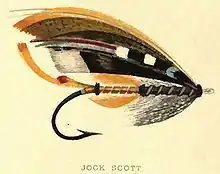 Jock Scott fly variation | |
| Type | Salmon fly |
| Imitates | imitator |
| History | |
| Creator | various |
| Created | 1800s |
| Variations | many |
| Materials | |
| Typical sizes | 1.25 to 3 inches |
| Typical hooks | Salmon fly hook |
| Thread | black |
| Tail | usually feather fibers (i.e. tippets, hackle) |
| Body | usually natural or light color dyed from rabbits, seal, and muskrat. |
| Wing | the most complicated and intricate part; usually made from feathers and tips of feathers (i.e. turkey, duck, bustard, jay) either separate feathers or married feathers. Usually the color complements the body and presents a theme. |
| Ribbing | mostly tinsel, floss, or wire in gold, silver; oval or flat. |
| Thorax | tied like a nymph fly's beard that is only on the bottom of the hook and extends to the point (i.e. Guinea, Honey Dun Hackle). |
| Legs | none |
| Tag | a small portion tied on the bend before the tai; usually floss or tinsel |
| Butt | small ball of fur dubbing, herl, or Krystal Flash; tied after the tail and before the body (similar to midsection, shoulder) |
| Cheek | small feather tied on each side of the wing just before tying the head, contrasts the wing and body slightly. |
| Head | usually thread or fur, tied in at the end behind the eye; usually with thread it is tied to present a smooth "head"; with fur to hide small tips left from the wing (with same purpose as thread head). |
| Bead | none |
| Uses | |
| Primary use | Salmon |
Fully dressed flies are elaborate and colorful artificial flies used in fly fishing. The most famous of these are the classic salmon flies, which are exquisite patterns made from mostly rare and beautiful materials and feathers, including golden pheasants, toucans, swans, and ivory-billed woodpeckers. These flies have been popular in the United Kingdom since the 19th century.[1][2] Fully dressed flies are often meant for display and are not used in actual fishing.[3][4] Many patterns are expensive to tie because of the cost of rare feathers.[4][5]
Parts
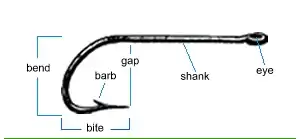
Parts of fishhook
Parts of a fully dressed fly, as listed in Kelson's 1895 book, are shown below.[6]
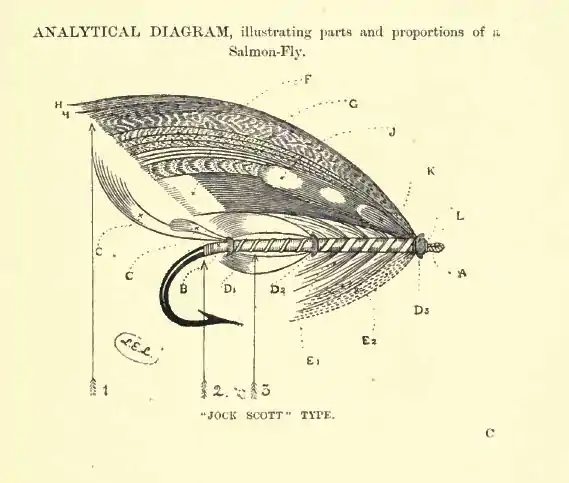 Parts of a salmon fly in correct proportion[6] |
Key to Parts of Salmon Fly Image[6]
|
The key to the figure as explained by Kelson with comments in parentheses are listed below.
- A. Gut loop[6] (hook eye)
- B.Tag, Here in two sections, silver twist followed by floss silk, a small portion tied on the bend before the tail[6] (usually floss or tinsel)
- C. C. Tail, of a topping and usually of a crow feathers (usually feather fibers[6] (i.e. feather tippets, hackle)
- D1, D2, D3. Butts Between D1 (tail butts) and D3 (head butts) lies the body divided in this type of fly into two sections by D2 (section butt), each section having 5 ribs of tinsel; D3 is here preceded by (in order of construction) by Toucan feathers above and below.[6] (small ball of fur dubbing, herl, or Krystal Flash; tied after the tail and before the body (similar to midsection, shoulder)
- E. Hackle, here distinguished as "Upper section hackle". When wound over the whole length of the fly it is termed "Body Hackle" (Throat/Beard-fibers tied like a nymph fly's beard that is only on the bottom of the hook and extends to the point[6] (i.e. Guinea, Honey Dun Hackle).
- E2. Throat Hackle, usually written "throat"[6]
- F. Under wing. Here of "White tipped turkey"[6]
- G. Over Wing, in most flies capped with a "topping"[6] (the most complicated and intricate part; usually made from feathers and tips of feathers (i.e. turkey, duck, bustard, jay) either separate feathers or married feathers. Usually the color complements the body and presents a theme.
- HH. Horns[6]
- J. Sides[6] (thin feather sections tied before the cheeks, in an angle similar to the wing angle.)
- K. Cheeks[6] (small feather tied on each side of the wing just before tying the head, contrasts the wing and body slightly)
- L. Head[6] (usually thread or fur, tied in at the end behind the eye; usually with thread it is tied to present a smooth "head"; with fur to hide small tips left from the wing (with same purpose as thread head))
- 1. A line showing the proper length of the tail and wing beyond the hook-bend[6]
- 2. Indicates the place of the first coil of the tag relatively to the hook-barb, the best barb supplying the best guide to the eye in initial operation of tying on the "tag" material.[6]
- 3. Indicates place on the hook-shank (relatively to the hook-point), at which ends of the gut loop should terminate, leaving the gap, for adjustment[6]
See also
Gallery
Salmon Flies
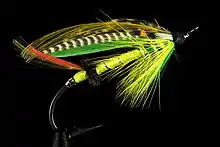 Green Highlander (1914)[7]
Green Highlander (1914)[7] Jock Scott (1850)[8]
Jock Scott (1850)[8]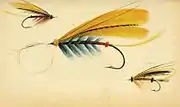 Salmon flies from the Book of Salmon by Edward Fitzgibbon (1850)[9]
Salmon flies from the Book of Salmon by Edward Fitzgibbon (1850)[9] Durham Ranger (mid 19th Century)[10]
Durham Ranger (mid 19th Century)[10]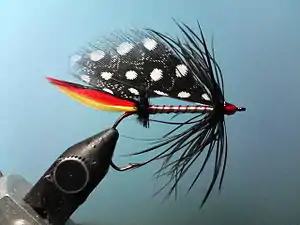 Triumph Bass Fly
Triumph Bass Fly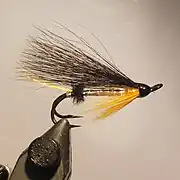 Mosca da salmone
Mosca da salmone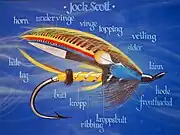 Labeled Jock Scott
Labeled Jock Scott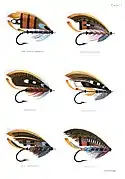
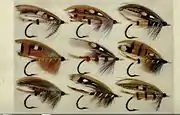 Plate of flies from T. E. Pryce-Tannatt (1914)[7]
Plate of flies from T. E. Pryce-Tannatt (1914)[7] Royal Coachman (1892)<ref name='Orvis'>Marbury, Mary Orvis (1892). Favorite Flies and Their Histories. Boston and New York: Houghton Mifflin and Company. pp. 97.
Royal Coachman (1892)<ref name='Orvis'>Marbury, Mary Orvis (1892). Favorite Flies and Their Histories. Boston and New York: Houghton Mifflin and Company. pp. 97.
References
- ↑ only two known patterns use ivory-billed woodpecker feathers
- ↑ Kevin W. Erickson (August 1, 2017). Feather Craft: The Amazing Birds and Feathers Used in Classic Salmon Flies. Stackpole Books. ISBN 0811717798.
- ↑ Luallen, Wayne (1997). Tying the Classic Salmon Fly: A Modern Approach to Traditional Techniques. Stackpole Books.
- 1 2 Hill, Lawrence (July 23, 2020). "Best Classical Salmon Patterns, A Guide to Productive Patterns". Into Fly Fishing. Retrieved March 13, 2021.
- ↑ Blacker, Willaim (1842). Blacker's Art of Fly Making. London: George Nichols.
- 1 2 3 4 5 6 7 8 9 10 11 12 13 14 15 16 17 18 19 Kelson, George M. (1895). The Salmon Fly-HOW TO DRESS IT AND HOW TO USE IT. London: Wyman and Sons Ltd. pp. 17–18.
- 1 2 Pryce-Tannatt, T. E. (1914). How To Dress Salmon Flies-A Handbook for Amateurs (PDF). London: Adam and Charles Black.
- ↑ Kontio, Timo. "Fly tying the Jock Scott Salmon Fly Step by Step". Fly Tying Archive. Retrieved March 13, 2021.
- ↑ Fitzgibbon, Edward (1850). The Book of Salmon (PDF). London: Longman, Brown, Green and Longmans.
- ↑ First tied in the mid 19th Century, most likely by Mr. William Henderson of Durham, England.
This article is issued from Wikipedia. The text is licensed under Creative Commons - Attribution - Sharealike. Additional terms may apply for the media files.
